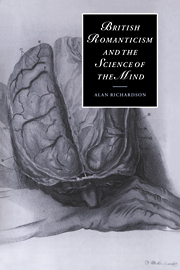Book contents
- Frontmatter
- Contents
- List of illustrations
- Preface
- List of abbreviations
- 1 Introduction: neural Romanticism
- 2 Coleridge and the new unconscious
- 3 A beating mind: Wordsworth's poetics and the “science of feelings”
- 4 Of heartache and head injury: minds, brains, and the subject of Persuasion
- 5 Keats and the glories of the brain
- 6 Embodied universalism, Romantic discourse, and the anthropological imagination
- 7 Epilogue
- Notes
- Bibliography
- Index
- CAMBRIDGE STUDIES IN ROMANTICISM
1 - Introduction: neural Romanticism
Published online by Cambridge University Press: 22 September 2009
- Frontmatter
- Contents
- List of illustrations
- Preface
- List of abbreviations
- 1 Introduction: neural Romanticism
- 2 Coleridge and the new unconscious
- 3 A beating mind: Wordsworth's poetics and the “science of feelings”
- 4 Of heartache and head injury: minds, brains, and the subject of Persuasion
- 5 Keats and the glories of the brain
- 6 Embodied universalism, Romantic discourse, and the anthropological imagination
- 7 Epilogue
- Notes
- Bibliography
- Index
- CAMBRIDGE STUDIES IN ROMANTICISM
Summary
This is a book about Romantic literary culture and the brain in Great Britain, from the 1790s to around 1830. It argues both that the pioneering neuroscience of the era manifests a “Romantic” character, and that literary Romanticism intersects in numerous and significant ways with the physiological psychology of the time. It aims, in short, to give the brain a central place in the history of the Romantic mind. But what, you may already be wondering, could the brain have to do with British Romanticism? To look at the relevant literary and cultural histories, not much. Fifty years ago one could publish a book reducing the psychological thought of the era to “the psychology of the association of ideas,” Hartleyan associationism stripped of the neural substrate Hartley had welded to it. Things are not much different now, although a half-century of psychoanalytically inspired literary analysis has piqued scholarly interest in Mesmerism and other Romantic-era anticipations of depth psychology. Most work on the Romantic mind continues to be informed by a disembodied version of associationism, by psychoanalysis, or by epistemological issues that link Romantic literary figures to a philosophical tradition running from German idealism to phenomenology and its deconstruction. The Romantic brain, however, has been left almost wholly out of account.
The history of science and medicine tells quite a different story.
- Type
- Chapter
- Information
- British Romanticism and the Science of the Mind , pp. 1 - 38Publisher: Cambridge University PressPrint publication year: 2001



